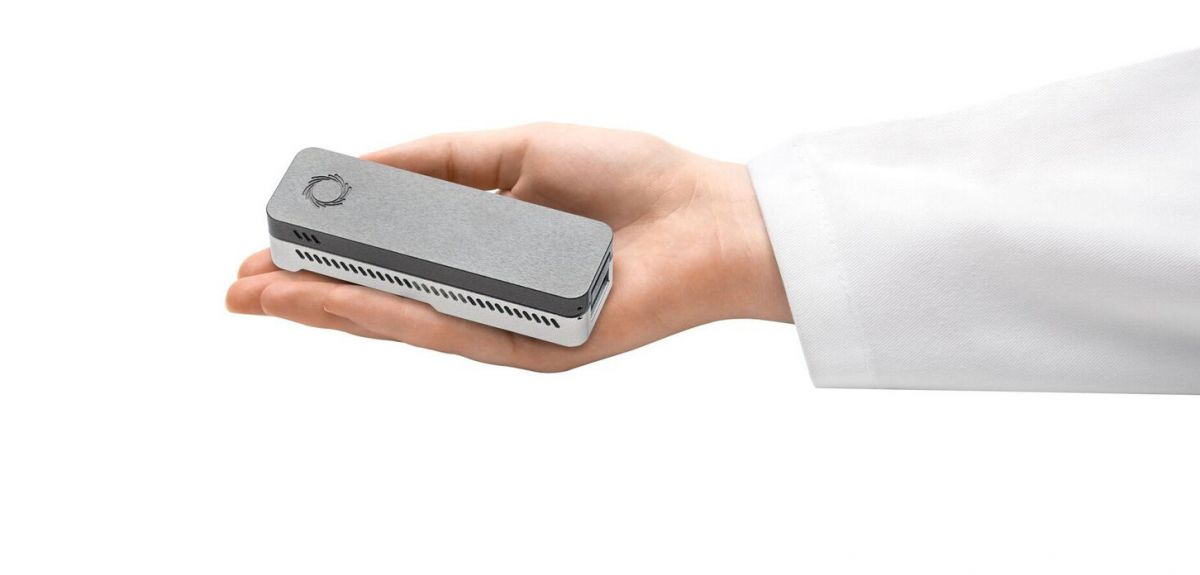
Mini DNA sequencer’s data belies its size
A miniature DNA sequencing device that plugs into a laptop and was developed by Oxford Nanpore has been tested by an open, international consortium, including Oxford University researchers. The results show that it provides good, repeatable results that can be just as useful as those provided by larger, more expensive devices.
The MinION is a handheld DNA-sequencing device developed by Oxford Nanopore, a spin-out company from the University of Oxford. The smallest high-throughput sequencing system currently available, the device can be plugged into any computer using a USB port, weighs just 90 grams and measures 10 centimetres in length. It works by detecting individual DNA bases that pass through a nanopore — a tiny hole in a membrane. When the DNA bases pass through or near the nanpore, they create a distinctive electrical current, allowing the device to read long DNA sequences in a way that is not possible on most other devices.
The sequencer has been made available to thousands of laboratories around the world via the MinION Access Programme, all of them keen to test the abilities of the small device and contribute to its future development. As part of that process, five laboratories involved in an international consortium— from the UK, the US, Canada and The Netherlands, including a team from Oxford’s Wellcome Trust Centre for Human Genetics — have carried out a series of experiments to assess the accuracy and reproducibility of the data the device produces.
The laboratories carried out two sets of ten experiments, sequencing the genome of a laboratory strain of E. coli (Escherichia coli K-12). Working to a single, shared protocol, the consortium produced 20 data sets with enough results to be able to quantify the data yield, quality, accuracy and reproducibility that can be expected from the MinION.
The findings show that the device provided consistent results between labs which were all of good quality. While the data from the MinION device did contain more errors than larger, more expensive devices — so-called standard short-read technologies — other researchers have shown that they’re of high enough quality to infer full-length genomes from scratch, for the E. coli bacterium, Influenza virus, and the Saccharomyces cerevisiae yeast genomes. The researchers of this study point out, though, that there is work still to be done, to improve the reproducible delivery of molecules into the device and the clarity of the software it uses.
The results are published online at F1000Research, an open access, open peer-review scientific publishing platform that allows the team to quickly disseminate their findings for use by other researchers. “We’ve published the paper in F1000Research before peer review as a baseline for the community, so that everyone can look at the paper and data, go on to do their own analyses share their results and stimulate discussion,” explains Dr David Buck of Oxford University.
The rapidity with which the findings are released is important: the data generated in the study actually represents a snapshot of the MinION’s performance in April 2015. Since then, innovation on the device has outpaced analysis, with new chips and kits released every 3-6 months.
“In a few years time, people who may be several steps removed from basic genomic research, like teachers in a classroom, could be using this device to teach science in new, exciting ways that have never been possible before,” explains Dr Camilla Ip, lead author of the study and Senior Analyst in Microbial Genomics at the Wellcome Trust Centre for Human Genetics. “I’m using the MinION in a project with secondary-school students in Oxford, because this technology will probably be so much a part of daily life in a few years time that they take it for granted.”
The next phase of analysis is already underway by the consortium, which is exploring ways to reduce the error rate of the device as well as ensuring that it can work with small samples of DNA.
A report of the research, entitled ‘MinION Analysis and Reference Consortium: Phase 1 data release and analysis’ is published on F1000Research.
 New study on Amazonia's fire crises urges action ahead of the next burning season
New study on Amazonia's fire crises urges action ahead of the next burning season
 New heart disease calculator could save lives by identifying high-risk patients missed by current tools
New heart disease calculator could save lives by identifying high-risk patients missed by current tools
 Modern Slavery and Human Rights Policy and Evidence Centre moves to Oxford University after receiving continuation funding
Modern Slavery and Human Rights Policy and Evidence Centre moves to Oxford University after receiving continuation funding
 Study shows that island bats are valuable allies for farmers
Study shows that island bats are valuable allies for farmers
 Study reveals how humanity could unite to address global challenges
Study reveals how humanity could unite to address global challenges